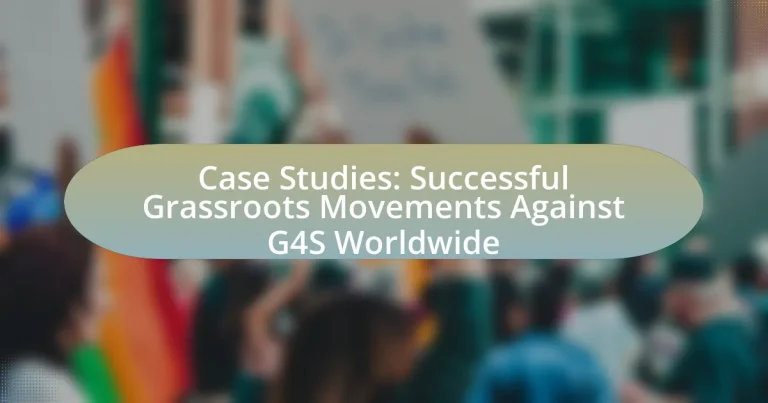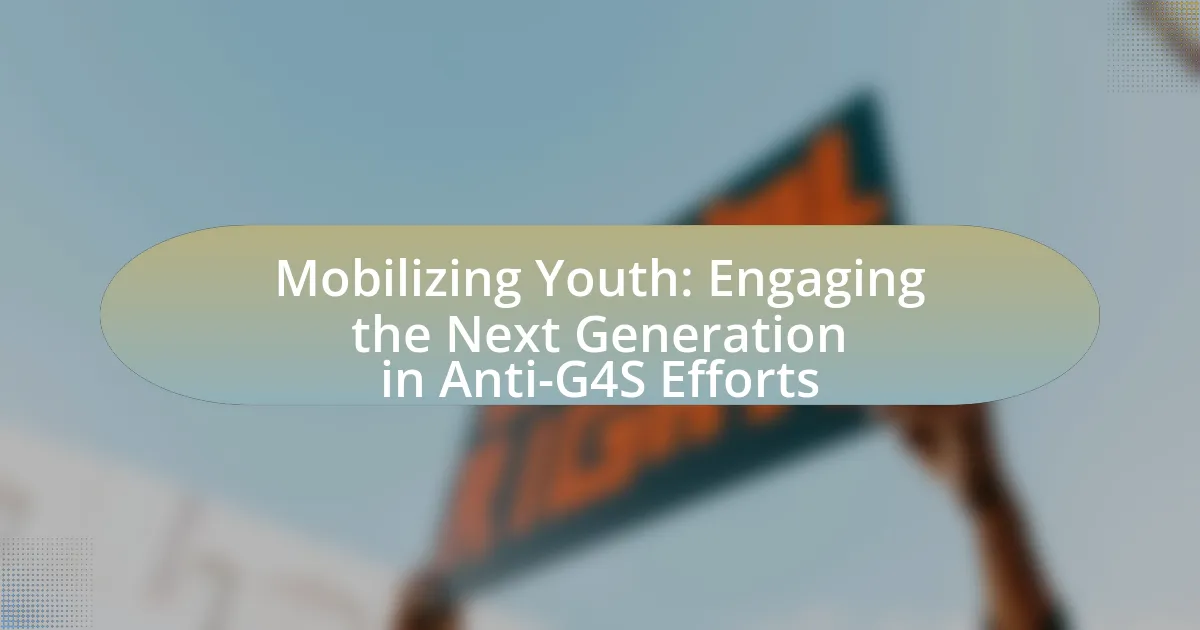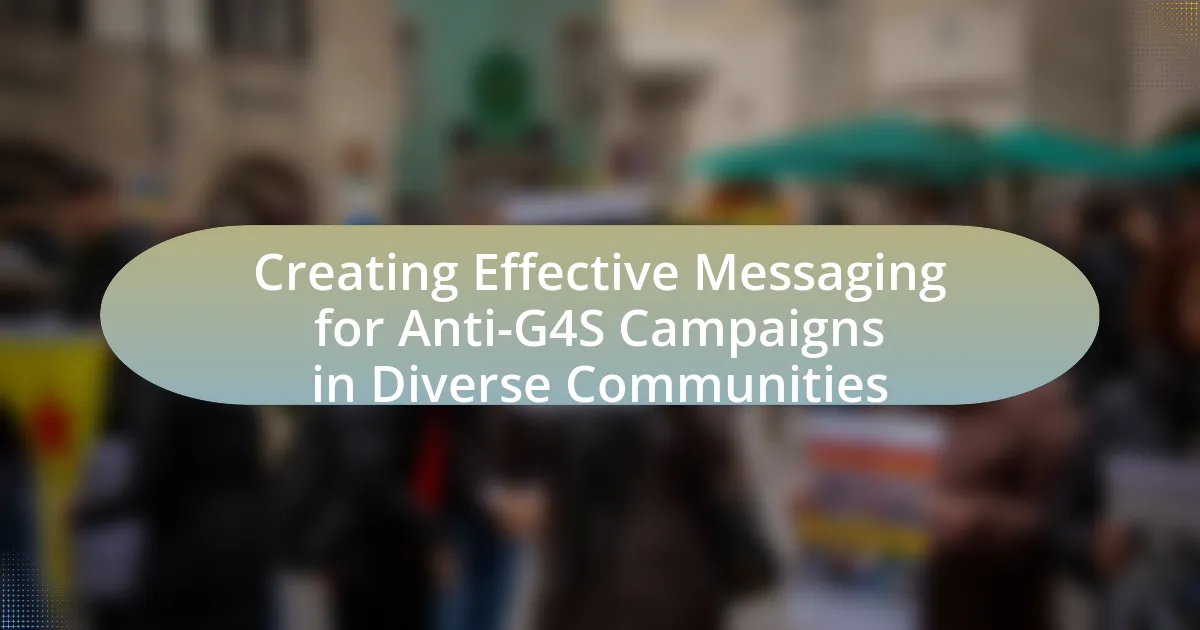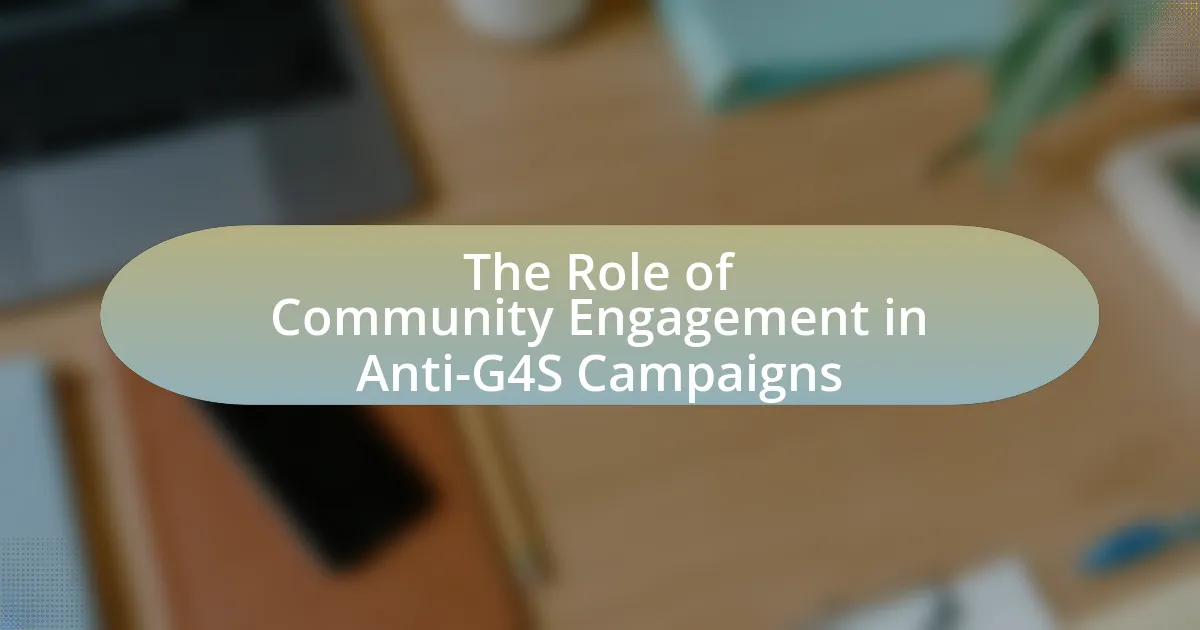Grassroots movements against G4S, a multinational security company, have emerged globally to challenge its controversial practices, including human rights abuses and involvement in detention centers. These movements, such as the “Boycott G4S” campaign in the UK and protests in South Africa, utilize community mobilization, social media, and coalition-building to raise awareness and advocate for change. Key factors contributing to these movements include public dissatisfaction with G4S’s operations, political accountability issues, and economic pressures from austerity measures. The article explores notable case studies, strategies employed by activists, and the impact of grassroots efforts on G4S’s policies and public perception, highlighting the effectiveness of community-driven activism in promoting social justice.

What are Grassroots Movements Against G4S Worldwide?
Grassroots movements against G4S worldwide are organized efforts by local communities and activists aimed at challenging the practices and policies of G4S, a multinational security company. These movements have emerged in response to G4S’s involvement in controversial activities, such as operating detention centers, providing security for Israeli settlements, and alleged human rights abuses. For instance, in the UK, the “Boycott G4S” campaign has gained traction, advocating for divestment from G4S due to its role in the Israeli-Palestinian conflict. Similarly, in South Africa, activists have protested against G4S’s management of prisons, highlighting issues of overcrowding and mistreatment of inmates. These grassroots initiatives often utilize social media, public demonstrations, and partnerships with human rights organizations to raise awareness and mobilize support, demonstrating the effectiveness of community-driven activism in holding corporations accountable.
How do grassroots movements emerge in response to G4S?
Grassroots movements emerge in response to G4S primarily due to community mobilization against perceived injustices and human rights violations associated with the company’s operations. These movements often begin when local communities, activists, or organizations identify specific grievances, such as issues related to privatization of public services, excessive use of force by security personnel, or complicity in state violence. For instance, in the UK, campaigns like “Boycott G4S” arose from public outrage over the company’s involvement in the Israeli occupation of Palestine, highlighting the intersection of local and global issues. The emergence of these movements is often fueled by social media, which facilitates rapid information sharing and mobilization, allowing affected individuals to connect and organize effectively.
What social, political, or economic factors contribute to these movements?
Social, political, and economic factors significantly contribute to grassroots movements against G4S worldwide. Socially, widespread public dissatisfaction with G4S’s practices, such as allegations of human rights abuses and privatization of public services, mobilizes communities to advocate for change. Politically, the lack of accountability and transparency from governments that contract G4S fosters an environment where citizens feel compelled to organize and protest against perceived injustices. Economically, the impact of austerity measures and budget cuts often leads to increased reliance on private security firms like G4S, prompting communities to resist the commodification of public safety and demand equitable alternatives. These factors collectively create a fertile ground for grassroots activism aimed at challenging G4S’s operations and advocating for social justice.
How do local communities mobilize against G4S?
Local communities mobilize against G4S through organized protests, community meetings, and coalition-building with other activist groups. These actions often focus on raising awareness about G4S’s controversial practices, such as its involvement in immigration detention and security services linked to human rights abuses. For example, in the UK, grassroots campaigns like “No to G4S” have successfully engaged local residents and garnered media attention, leading to public pressure on institutions to sever ties with the company. Additionally, communities utilize social media platforms to disseminate information and coordinate efforts, amplifying their message and fostering solidarity among diverse groups.
What are the key characteristics of successful grassroots movements against G4S?
Successful grassroots movements against G4S typically exhibit strong community engagement, clear messaging, and strategic alliances. Community engagement is crucial as it fosters local support and mobilizes individuals to participate actively in campaigns. Clear messaging ensures that the objectives and demands of the movement are easily understood, which helps in rallying broader public support. Strategic alliances with other organizations amplify the movement’s reach and resources, enhancing its effectiveness. For instance, the Boycott G4S campaign successfully united various groups, including human rights organizations and student unions, to challenge G4S’s involvement in controversial practices, demonstrating the power of collaboration in grassroots efforts.
What strategies do these movements employ to gain traction?
Grassroots movements against G4S employ strategies such as community engagement, social media mobilization, and coalition building to gain traction. Community engagement involves organizing local events and discussions to raise awareness about G4S’s practices, fostering a sense of solidarity among affected individuals. Social media mobilization leverages platforms like Twitter and Facebook to disseminate information rapidly, allowing movements to reach a broader audience and galvanize support. Coalition building entails forming alliances with other organizations and activists, enhancing resources and visibility, which has proven effective in campaigns like the Boycott G4S movement, where diverse groups united to challenge the company’s operations in Palestine. These strategies collectively enhance the movements’ visibility and impact, leading to increased public support and pressure on G4S.
How do they leverage social media and technology?
Grassroots movements against G4S leverage social media and technology to mobilize supporters, disseminate information, and coordinate actions effectively. These movements utilize platforms like Twitter, Facebook, and Instagram to share real-time updates, campaign messages, and visual content that raise awareness about their causes. For instance, the hashtag campaigns often trend on social media, amplifying their reach and engaging a broader audience. Additionally, technology tools such as online petitions and crowdfunding platforms facilitate grassroots fundraising and support, enabling these movements to sustain their initiatives and expand their impact. The effectiveness of these strategies is evidenced by the rapid growth of online communities and the increased visibility of their campaigns, leading to significant public discourse and pressure on G4S.
What impact do grassroots movements have on G4S operations?
Grassroots movements significantly impact G4S operations by influencing public perception and prompting changes in corporate practices. For instance, campaigns led by organizations such as Boycott G4S have raised awareness about the company’s involvement in controversial activities, including security services in conflict zones. This heightened scrutiny has led to divestment from G4S by various institutions, including universities and pension funds, which directly affects the company’s revenue and market position. Additionally, grassroots activism has pressured G4S to adopt more ethical policies and practices, as seen in their commitment to human rights training for employees following public outcry.
How do these movements influence public perception of G4S?
Grassroots movements significantly influence public perception of G4S by highlighting the company’s controversial practices and advocating for accountability. These movements often mobilize public sentiment against G4S through campaigns that expose issues such as human rights violations and unethical business practices, leading to increased scrutiny and criticism. For instance, campaigns like “Boycott G4S” have successfully raised awareness about the company’s involvement in the Israeli-Palestinian conflict, resulting in a decline in contracts and partnerships, as evidenced by universities and organizations severing ties with G4S in response to public pressure. This shift in public perception can lead to reputational damage and financial repercussions for G4S, demonstrating the tangible impact of grassroots activism on corporate image.
What changes have occurred in G4S policies due to grassroots activism?
G4S has implemented significant changes in its policies in response to grassroots activism, particularly regarding human rights and ethical practices. Activism has led G4S to enhance its commitment to corporate social responsibility, resulting in the adoption of more stringent human rights policies and the establishment of a dedicated human rights framework. For instance, following sustained pressure from activist groups, G4S has pledged to cease operations in certain controversial areas, such as the Israeli-Palestinian conflict, and has increased transparency in its operations. These changes reflect a direct response to public campaigns and protests that highlighted the company’s involvement in activities deemed unethical, thereby influencing its operational strategies and corporate governance.
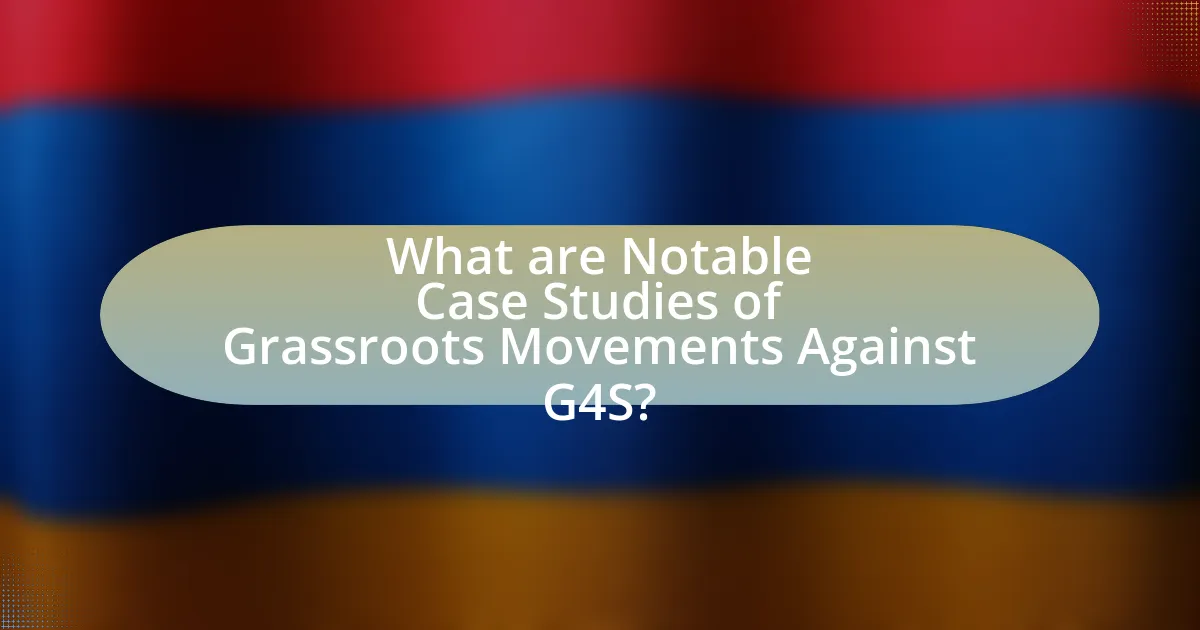
What are Notable Case Studies of Grassroots Movements Against G4S?
Notable case studies of grassroots movements against G4S include the Boycott, Divestment, Sanctions (BDS) movement, which targets G4S for its involvement in Israeli prisons and security services. This movement has successfully pressured various institutions, including universities and local governments, to divest from G4S, citing its role in human rights violations. Another significant case is the campaign led by the UK-based group “No to G4S,” which has organized protests and awareness-raising activities to highlight G4S’s involvement in the detention of migrants and asylum seekers. These grassroots efforts have resulted in increased public scrutiny and calls for accountability, demonstrating the effectiveness of community mobilization against corporate practices.
How did the movement in the UK challenge G4S’s practices?
The movement in the UK challenged G4S’s practices by exposing the company’s involvement in human rights abuses and unethical operations, particularly in relation to immigration detention and security services. Activists organized protests, campaigns, and public awareness initiatives that highlighted G4S’s role in the mistreatment of detainees and its contracts with the UK government. For instance, the “No Borders” campaign and various grassroots organizations documented instances of abuse within G4S-run facilities, leading to public outcry and calls for accountability. This sustained pressure resulted in significant scrutiny of G4S’s contracts, ultimately prompting some institutions, such as universities, to sever ties with the company due to ethical concerns.
What specific actions did activists take to raise awareness?
Activists raised awareness through organized protests, social media campaigns, and educational outreach. For instance, they conducted demonstrations outside G4S facilities to highlight human rights violations, which garnered media attention and public support. Additionally, activists utilized platforms like Twitter and Facebook to disseminate information about G4S’s practices, reaching a broader audience and mobilizing supporters. Educational workshops and community events were also held to inform the public about the implications of G4S’s operations, effectively engaging local communities in the movement.
What were the outcomes of the UK movement against G4S?
The outcomes of the UK movement against G4S included significant public awareness of the company’s controversial practices, leading to increased scrutiny and criticism of its operations. Activists successfully pressured various institutions, including universities and local governments, to sever ties with G4S, resulting in contract cancellations and reduced business opportunities for the company. For instance, in 2013, the University of Edinburgh ended its contract with G4S following protests, highlighting the effectiveness of grassroots activism in influencing institutional decisions. Additionally, the movement contributed to broader discussions on human rights and corporate accountability, reinforcing the importance of ethical considerations in public contracts.
What lessons can be learned from the movement in South Africa?
The movement in South Africa teaches the importance of grassroots organization and community solidarity in effecting social change. This is evidenced by the anti-apartheid struggle, where collective action and mobilization of local communities played a crucial role in dismantling systemic oppression. The success of the movement was largely due to the ability to unite diverse groups under a common cause, demonstrating that inclusive participation strengthens advocacy efforts. Additionally, the movement highlighted the effectiveness of strategic nonviolent resistance, as seen in protests and boycotts that garnered international attention and support, ultimately leading to policy changes.
What unique challenges did activists face in this context?
Activists faced unique challenges such as intense corporate opposition and legal barriers in their efforts against G4S. The company, being a global security firm, utilized its substantial resources to counteract activist campaigns, often employing legal tactics to silence dissent and intimidate participants. For instance, activists encountered lawsuits aimed at discrediting their claims and limiting their ability to organize public demonstrations. Additionally, activists faced difficulties in mobilizing public support due to G4S’s extensive media influence and public relations strategies, which often portrayed the company in a favorable light despite its controversial practices. These challenges highlight the complex dynamics activists navigated while striving for social justice and accountability in the context of G4S’s operations.
How did local culture influence the movement’s strategies?
Local culture significantly influenced the movement’s strategies by shaping the messaging and methods used to engage the community. For instance, grassroots movements often incorporated local traditions, languages, and values to resonate with the population, thereby enhancing participation and support. In various case studies, such as those against G4S in different regions, activists tailored their campaigns to reflect cultural narratives, which helped in mobilizing local support and fostering a sense of ownership among community members. This cultural alignment not only increased the effectiveness of outreach efforts but also strengthened the legitimacy of the movements, as seen in successful campaigns that utilized local art forms and community gatherings to raise awareness and build solidarity.
What role did international solidarity play in movements against G4S?
International solidarity played a crucial role in movements against G4S by uniting activists and organizations across borders to amplify their collective voice and pressure the company. This global collaboration enabled local movements to gain visibility and support, as seen in campaigns like the Boycott, Divestment, Sanctions (BDS) movement, which mobilized international public opinion against G4S’s involvement in Israeli security operations. The effectiveness of international solidarity is evidenced by G4S’s decision to sell its Israeli operations in 2016, a move influenced by sustained global activism and pressure from various human rights organizations.
How did global networks support local activists?
Global networks supported local activists by providing resources, amplifying their voices, and facilitating connections across borders. For instance, organizations like Amnesty International and Human Rights Watch mobilized international attention to local issues, enabling activists to gain visibility and support for their causes. Additionally, social media platforms allowed local movements to share their narratives globally, attracting solidarity and financial contributions from international supporters. This interconnectedness was crucial in campaigns against G4S, where local activists benefited from global advocacy efforts that pressured governments and corporations to address human rights violations.
What examples illustrate successful international collaboration?
Successful international collaboration is illustrated by the global campaign against G4S, which involved various grassroots movements uniting across countries to challenge the company’s practices. For instance, the collaboration between organizations like the Palestinian BDS National Committee and international labor unions led to coordinated boycotts and divestment campaigns targeting G4S for its involvement in the Israeli occupation. This collective effort resulted in significant financial losses for G4S, as evidenced by their decision to sell off their Israeli operations in 2016, demonstrating the effectiveness of unified international action against a common adversary.
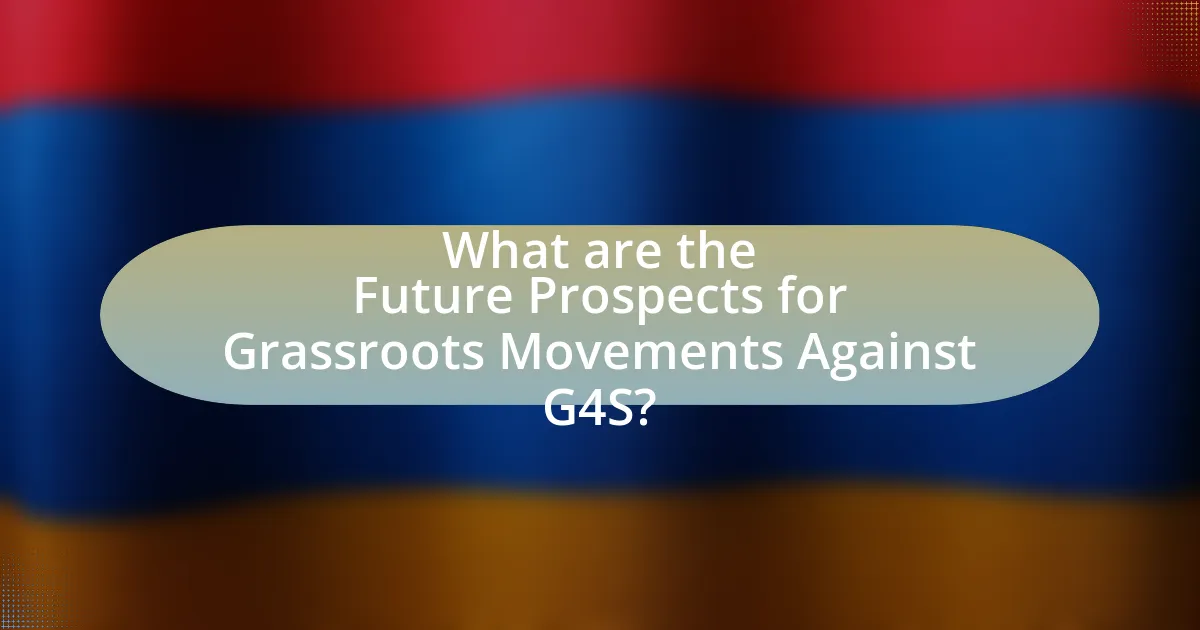
What are the Future Prospects for Grassroots Movements Against G4S?
The future prospects for grassroots movements against G4S appear promising due to increasing public awareness and activism surrounding human rights issues. Movements have gained traction through social media campaigns and community organizing, leading to heightened scrutiny of G4S’s practices, particularly in areas such as immigration detention and security services. For instance, the growing coalition of advocacy groups has successfully pressured institutions to sever ties with G4S, as seen in the case of universities and local governments that have divested from contracts with the company. This trend indicates a potential for sustained momentum in grassroots efforts, as public sentiment increasingly favors accountability and ethical practices in security services.
How can grassroots movements sustain momentum over time?
Grassroots movements can sustain momentum over time by fostering strong community engagement and maintaining clear communication channels. Engaging community members through regular meetings, social media updates, and collaborative events helps to build a sense of ownership and commitment among participants. For instance, the Black Lives Matter movement has effectively utilized social media to mobilize supporters and keep the conversation alive, resulting in sustained activism over several years. Additionally, establishing partnerships with local organizations and leveraging existing networks can amplify efforts and resources, as seen in various successful campaigns against G4S, where coalitions have strengthened advocacy and outreach. These strategies create a resilient framework that allows grassroots movements to adapt, grow, and maintain their influence over time.
What strategies can be employed to maintain engagement?
To maintain engagement in grassroots movements against G4S, strategies such as fostering community involvement, utilizing social media for outreach, and organizing regular events can be employed. Community involvement ensures that participants feel a sense of ownership and connection to the cause, which is critical for sustained engagement. Social media platforms serve as effective tools for disseminating information, mobilizing supporters, and creating a sense of community among activists. Regular events, such as workshops, rallies, or informational sessions, provide opportunities for face-to-face interaction, reinforcing commitment and enthusiasm among participants. These strategies have been observed in various successful movements, demonstrating their effectiveness in maintaining high levels of engagement.
How can movements adapt to changing political landscapes?
Movements can adapt to changing political landscapes by employing flexible strategies, leveraging technology, and building coalitions. For instance, grassroots movements often reassess their goals and tactics in response to shifts in political power or public sentiment, allowing them to remain relevant and effective. Historical examples include the Civil Rights Movement, which adjusted its strategies in response to changing legislation and public opinion, ultimately leading to significant legal and social changes. Additionally, the use of social media has enabled movements to mobilize quickly and communicate effectively, as seen in the Arab Spring, where rapid dissemination of information facilitated widespread protests against authoritarian regimes. These adaptive strategies are crucial for sustaining momentum and achieving long-term objectives in dynamic political environments.
What best practices can be adopted by new grassroots movements?
New grassroots movements can adopt best practices such as building a strong community network, utilizing social media for outreach, and focusing on clear, actionable goals. Establishing a robust community network fosters collaboration and support among members, which is essential for mobilizing efforts and resources. Social media serves as a powerful tool for reaching a wider audience, sharing information, and organizing events, as evidenced by movements like Black Lives Matter, which effectively used platforms to amplify their message. Additionally, setting clear, actionable goals helps maintain focus and measure progress, as seen in successful campaigns that have achieved specific policy changes or community initiatives.
What resources are available for activists looking to organize?
Activists looking to organize can access a variety of resources, including online platforms, community networks, and training programs. Online platforms such as social media and dedicated activist websites facilitate communication and mobilization, while community networks provide local support and collaboration opportunities. Training programs, often offered by established organizations, equip activists with skills in organizing, advocacy, and strategic planning. For instance, organizations like the Grassroots Institute for Fundraising Training offer workshops that enhance fundraising and organizing capabilities, which are crucial for effective grassroots movements.
How can movements effectively measure their impact?
Movements can effectively measure their impact by utilizing specific metrics such as changes in policy, public awareness levels, and community engagement statistics. For instance, successful grassroots movements often track legislative changes that result from their advocacy efforts, demonstrating a direct correlation between their actions and policy outcomes. Additionally, surveys and social media analytics can quantify shifts in public opinion and awareness, providing concrete data on the movement’s reach and influence. A notable example is the Black Lives Matter movement, which has seen measurable changes in local policing policies and increased public discourse on racial justice, illustrating the effectiveness of targeted impact measurement strategies.
What are the common challenges faced by grassroots movements against G4S?
Grassroots movements against G4S commonly face challenges such as limited funding, lack of media coverage, and resistance from local authorities. Limited funding restricts their ability to organize events, conduct outreach, and sustain campaigns, which is critical for mobilizing support. Lack of media coverage often results in insufficient public awareness of their causes, making it difficult to gain traction. Additionally, resistance from local authorities can manifest in legal obstacles, harassment, or outright opposition, which undermines their efforts to advocate for change. These challenges collectively hinder the effectiveness and reach of grassroots movements opposing G4S.
How can activists overcome funding and resource limitations?
Activists can overcome funding and resource limitations by leveraging community support, utilizing digital platforms for crowdfunding, and forming strategic partnerships with like-minded organizations. Community support can be mobilized through grassroots organizing, which fosters local engagement and encourages donations or volunteer efforts. Digital platforms, such as GoFundMe or Kickstarter, have enabled activists to reach a broader audience, allowing them to raise funds directly from supporters. Additionally, forming partnerships with other organizations can provide access to shared resources, expertise, and funding opportunities, enhancing the overall capacity of activist movements. For instance, the Black Lives Matter movement effectively utilized social media to raise millions in donations, demonstrating the power of digital fundraising in overcoming financial barriers.
What strategies can be used to counteract G4S’s influence?
To counteract G4S’s influence, grassroots movements can employ strategies such as community organizing, public awareness campaigns, and coalition-building. Community organizing involves mobilizing local residents to advocate for their rights and challenge G4S’s practices, as seen in various protests against the company’s operations in different regions. Public awareness campaigns can highlight G4S’s controversial actions, such as its involvement in privatized policing and immigration detention, thereby swaying public opinion against the company. Coalition-building with other organizations, including labor unions and human rights groups, can amplify efforts and resources, creating a united front that pressures G4S to change its policies. These strategies have been effective in various case studies, demonstrating the power of collective action in challenging corporate influence.
